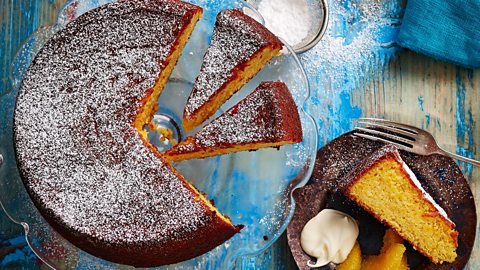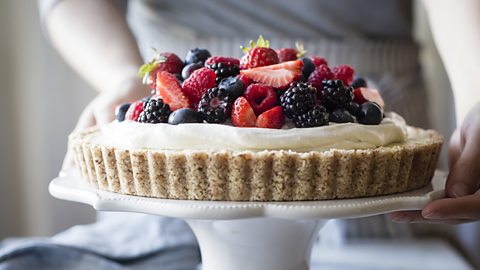Tips for gluten-free baking
Īű≥Ŕ‚Äôs (May 9-15), so a good time to shine a light on gluten-free baking ‚Äď surely the hardest part of cooking without gluten.
If you have a gluten intolerance, wheat allergy, coeliac disease or you're gluten-free by choice, it's likely you already know that making high-quality, gluten-free baked goods poses a particular problem. It's gluten that gives bread its elasticity and cakes their lightness.
Gluten-free flour is now available in most large supermarkets. But these flours are a little more difficult to work with than regular flours. It's just a matter of getting used to cooking with them.
The good news is that you can also use plenty of naturally gluten-free flour alternatives (rice, soy, chestnut, buckwheat, corn, potato and chickpea flour) for cakes, breads and pastries. And there are many recipes to show you how.

Cakes
Tips for baking gluten-free cakes
- Make your own blend of flours or ground nuts and flours. Adding sorghum or tapioca flour to a blend increases softness and absorbency, which is ideal for lighter cakes and pastries. Gluten-free oats and oat flours add texture, which works well in biscuits and breakfast muffins. Ground almonds, pistachios and hazelnuts are ideal in a blend for dense cakes, traybakes and biscuits.
- Polenta has a grainy texture, but is very absorbent and so brings moisture to cakes. It is commonly used in Northern Italian cakes and lemon polenta cake.
- Adding xanthan gum, to some extent, replaces the elastic qualities that gluten-free flours lack. This helps to reduce the risk of your cake crumbling and falling apart. If the flour you are using doesn't already contain xanthan gum, combining quarter of a teaspoon to every 200g/7oz of gluten-free flour will help to improve the crumb structure of your bake. You can also use guar gum or a combination of the two.
- Adding slightly more gluten-free baking powder than the recipe requires can help make a lighter and fluffier cake.
- Adding more liquid than stated in the recipe may be necessary in order to rehydrate gluten-free flour. Add the liquid a tablespoon at a time until the mixture reaches dropping consistency.
- Baking the cake for an extra 5‚Äď10 minutes may be necessary, due to the extra liquid content. You can test if the cake is cooked by inserting a skewer into the centre to see if it comes out clean.
- Decreasing the temperature slightly and increasing the cooking time could diminish the risk of a burnt top as gluten-free bakes may brown quicker.
Watch out for…
- Gluten-free baking powder is available to buy in supermarkets so don’t forget to buy the gluten-free version.
- Bicarbonate of soda is naturally gluten-free.
- Icing sugar is gluten-free in the UK, although in other countries it might contain modified starch as a bulking agent ‚Äď typically cornstarch is used, but wheat starch could also be used.
- Oats don't contain gluten, but they are often prepared in an environment where wheat may be present so it's best to check the label and purchase gluten-free oats.

Breads
As there is no gluten in the flour, no kneading is required! Don't be concerned that your dough has a wetter consistency ‚Äď it may be more like batter than traditional dough.
Tips for baking gluten-free breads
- Make sure your bread is completely cooked before taking it out of the oven. The best way to do this is using a cooking thermometer. The centre of the bread should be between 95‚Äď100C. Continue to cook the bread until it reaches this temperature.
- Gluten-free loaves continue to develop their structure until they are completely cool, so open the oven door and leave the loaf inside until it cools to room temperature. This help to avoid the bread sinking.
- Bake your bread in the middle of the oven. The top of the oven can be hotter, causing the top of the loaf to rise and cook far quicker than the rest.

Pastry
Converting a regular pastry recipe into a gluten-free version is tricky. But we have some tips to help you create the perfect gluten-free pastry.
Tips for baking gluten-free pastry
- Add xanthan gum to gluten-free flour. It enhances elastic qualities that gluten-free flours lack, making it easier to work with and less likely to crumble.
- Add plenty of water to the gluten-free flour to prevent the pastry from becoming too dry when rolling out. It should be a little sticky before covering and resting in the fridge.
- Choose a chilled (or even frozen) hard fat with a high melting point, such as butter or lard.
- Resting the pastry is very important. This will give the flour enough time to absorb the water so it will become more manageable. Refrigerate for a minimum of an hour or overnight if preferred.
- Try rolling out the pastry between two sheets of cling film, as the dough may be delicate, sticky and crumbly.